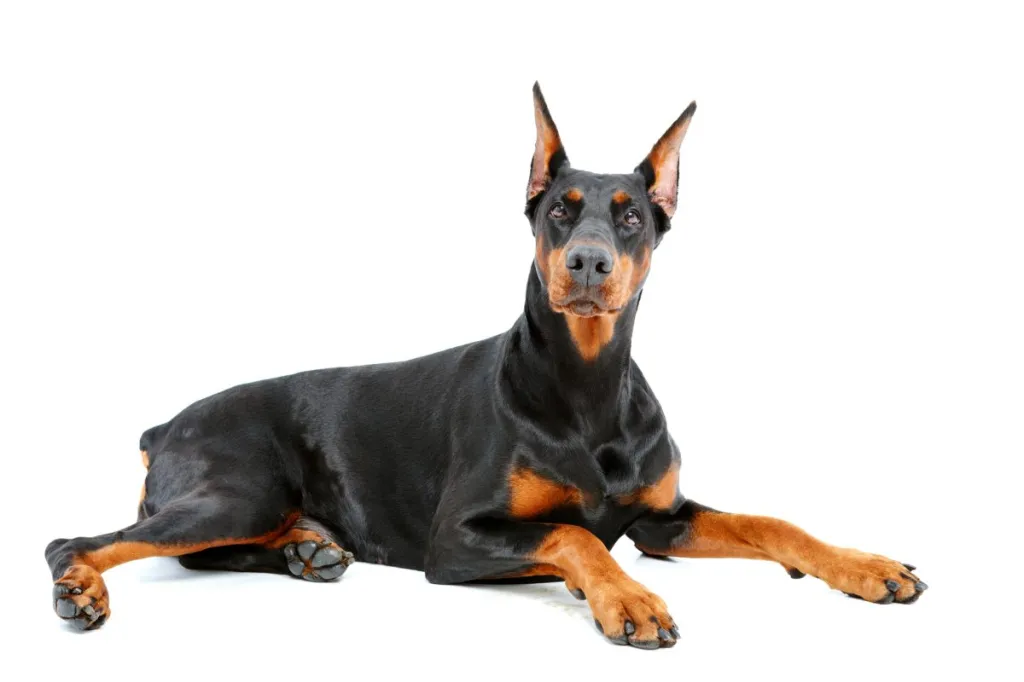The Doberman Pinscher is medium to large-sized dog that are known for their muscular build, sleek appearance, and intelligence. They are also known for being loyal, protective, and affectionate dogs. Doberman Pinschers are typically black or brown with rust-colored markings, and they have a short, smooth coat that is easy to care for.
Doberman Pinschers are originally from Germany, where they were bred in the late 19th century as guard dogs. They quickly became popular as family pets and working dogs, and today they are one of the most popular dog breeds in the world.
Doberman Pinschers are intelligent and easy to train, making them well-suited for a variety of tasks, including obedience, agility, and Schutzhund (a German dog sport that tests a dog’s obedience, tracking, and protection skills). They are also very protective of their families and make excellent guard dogs.
However, a Doberman Pinscher can be aggressive if they are not properly socialized and trained. They also require a fair amount of exercise, so they are not well-suited for apartment living.
Overall, Doberman Pinschers are loyal, intelligent, and protective dogs that make great family pets and working dogs. However, they require a firm and consistent owner who can provide them with plenty of exercise and training.
Quick Facts
- Origin: Germany.
- Size: Large; typically weighing 60 to 100 pounds (27 to 45 kilograms).
- Breed Group: Working Group.
- Lifespan: 10 to 13 years.
- Coat: Short, smooth coat that can come in black, red, blue, or fawn with rust markings.
- Temperament: Intelligent, loyal, and alert. Known for their protective nature and strong bond with their families.
- Exercise Needs: High; they are active dogs that require regular exercise and mental stimulation.
- Training: Highly trainable and eager to please. Consistent and positive training methods work well.
- Grooming: Low maintenance due to their short coat; regular brushing is sufficient.
- Health: Prone to certain genetic health issues like hip dysplasia and heart conditions. Regular veterinary check-ups are important.
- Pop culture references: Doberman Pinschers have been featured in many movies and TV shows, including “The Doberman Gang,” “The Sopranos,” and “The Simpsons.”
Doberman Pinscher Pictures
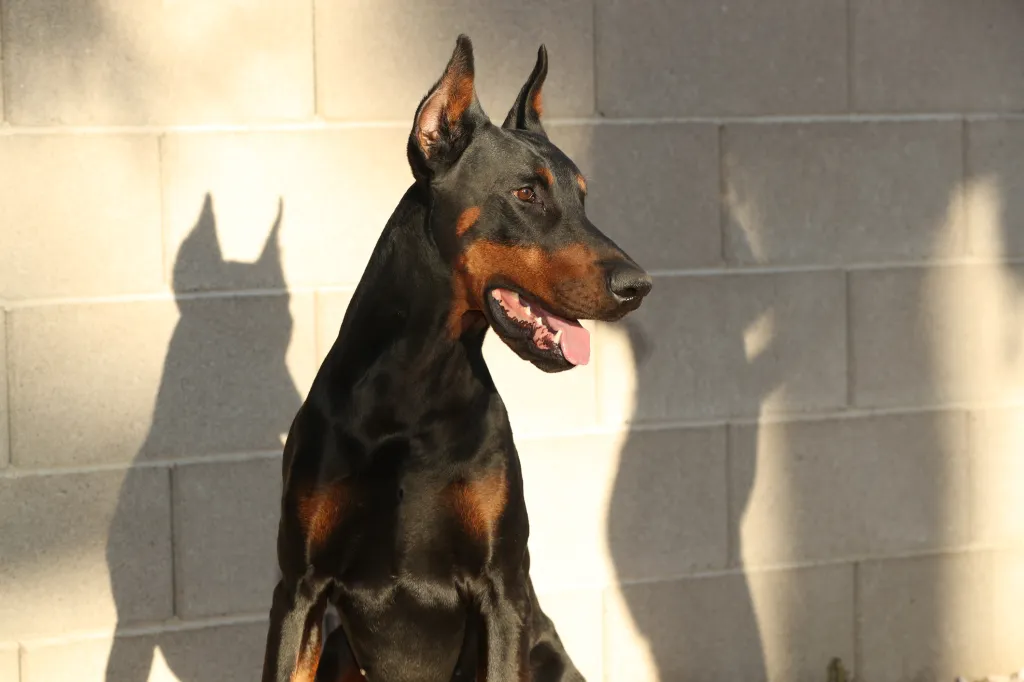
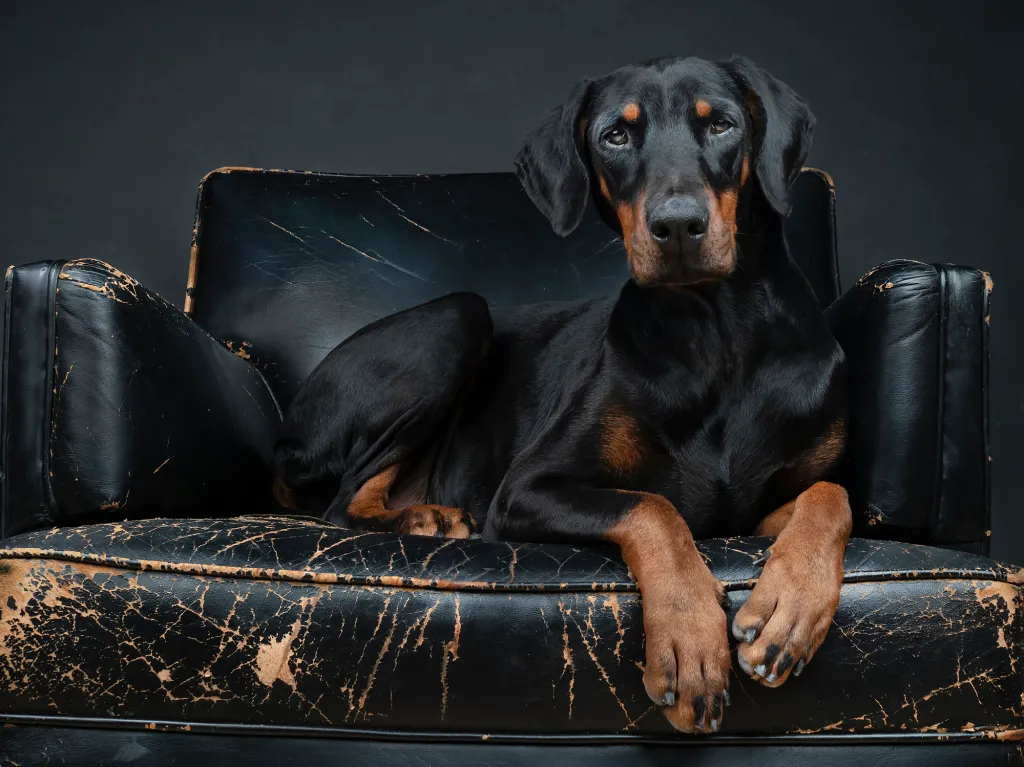
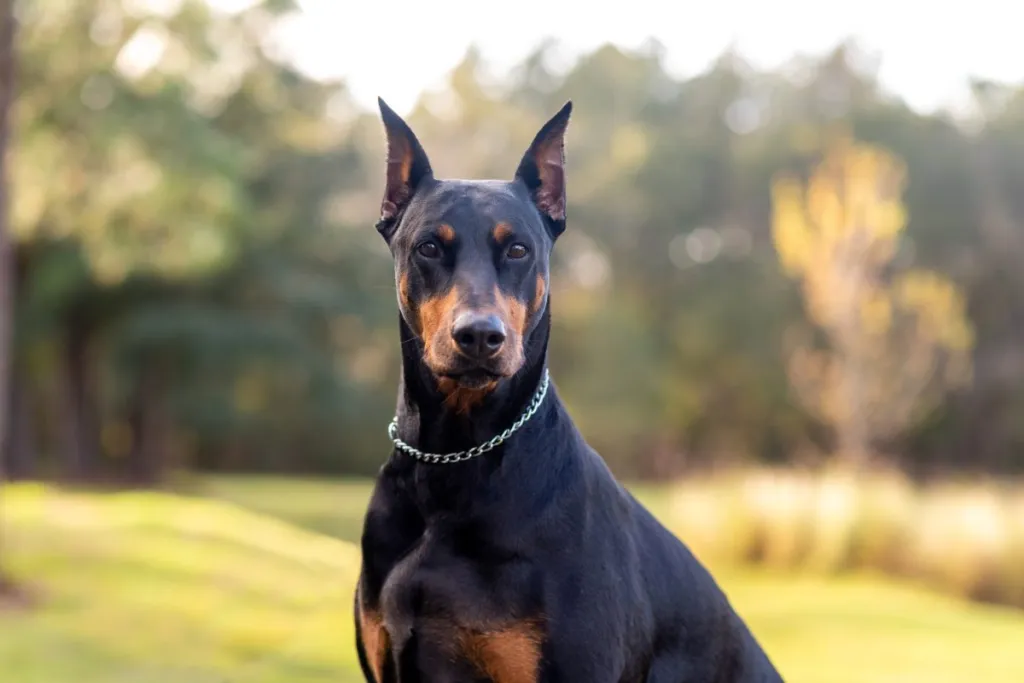
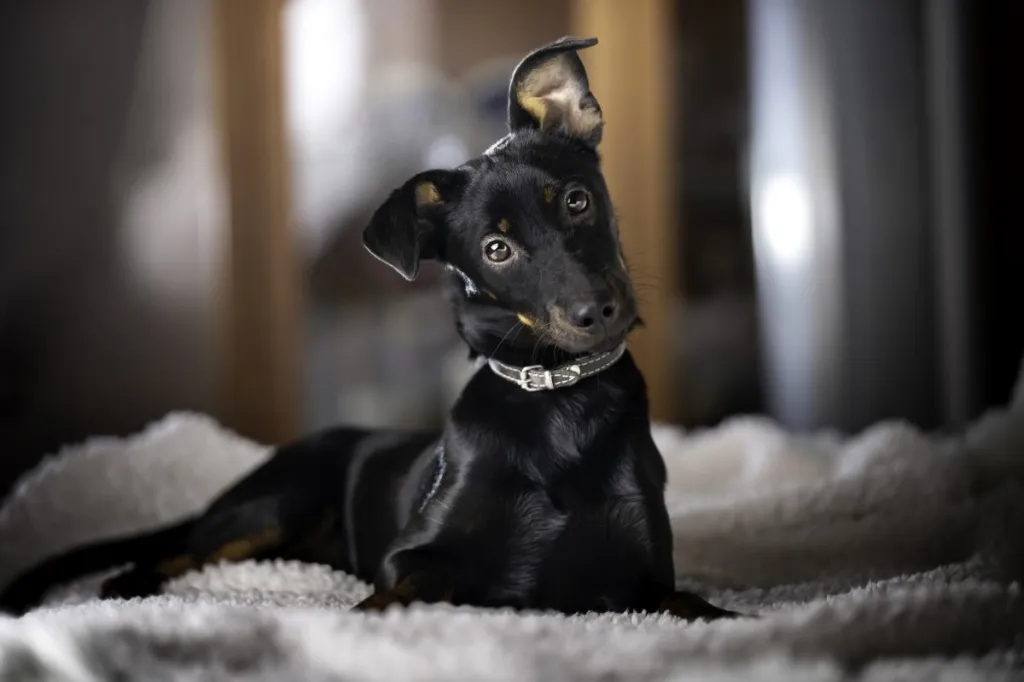
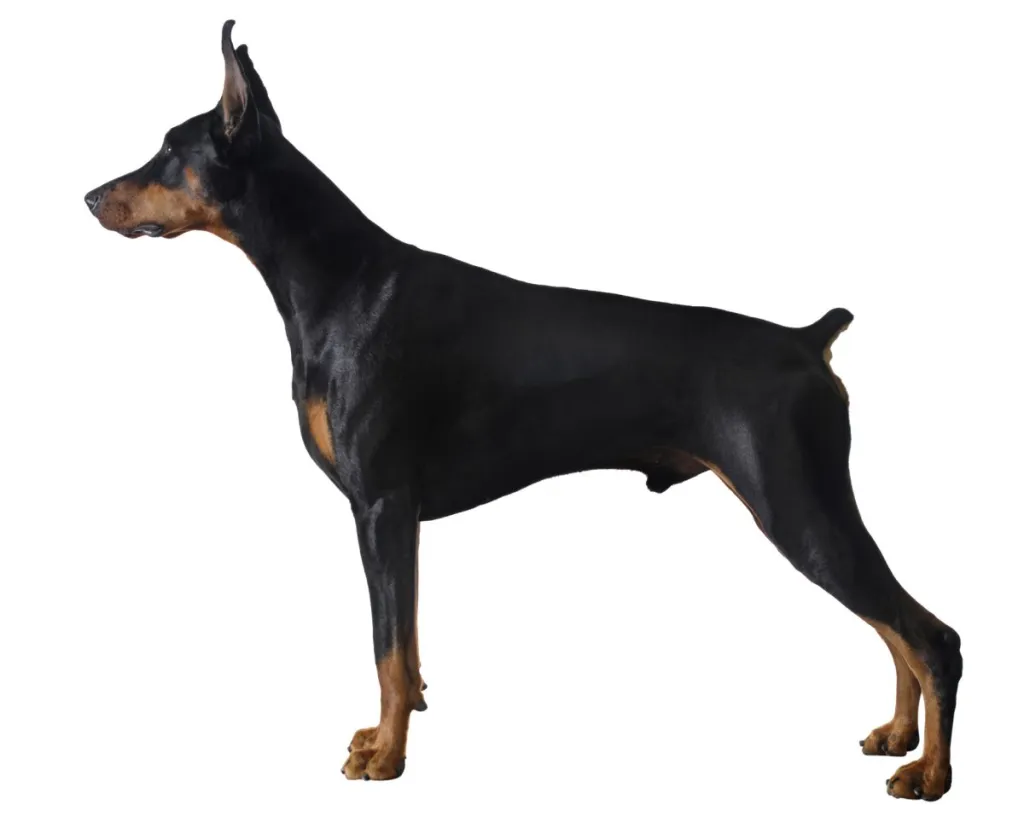
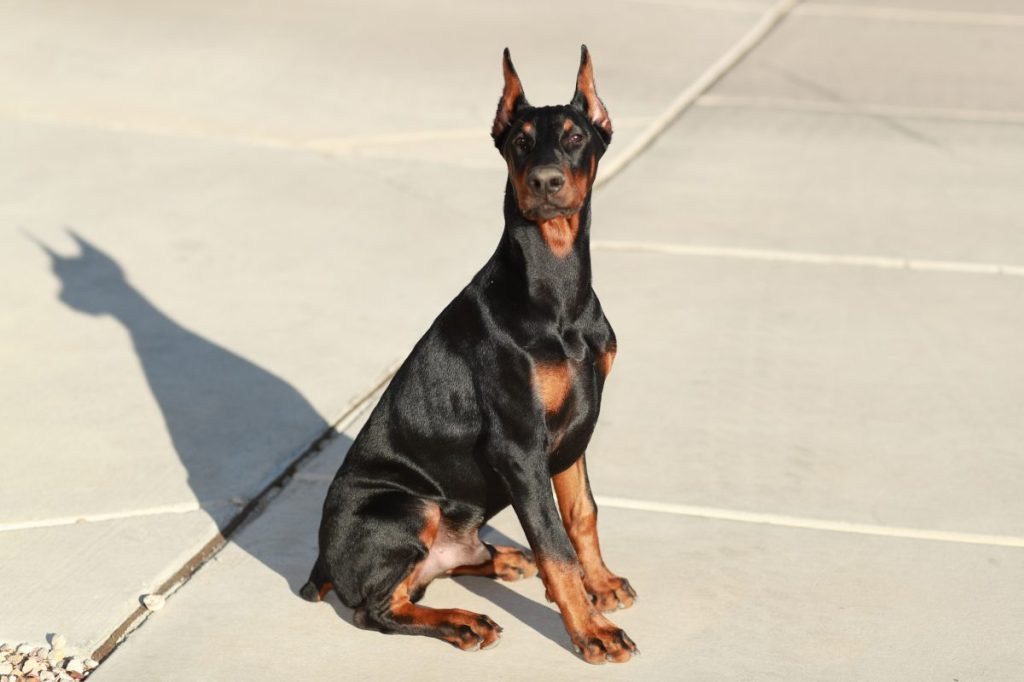
Adaptability
-
Adapts Well To Apartment Living
Looking for the best dog for your apartment? Contrary to popular belief, the suitability of dogs who adapt well to apartment living goes beyond its size. Apartment dwellers have a myriad of dog breeds to choose from as potential companions, with various factors to consider. Some large breeds can adapt well to apartment living and have lower activity levels. Others may require more space and possess higher energy levels. On the other hand, certain small dog breeds with abundant energy can still find contentment with indoor playtime or brisk walks.
However, when selecting a dog that adapts well apartments, it is essential to prioritize your neighbors. Opting for a pet that doesn’t excessively bark and behaves politely when encountering others in shared spaces like is crucial for maintaining a harmonious apartment environment.
In high-rise settings, it’s worth noting that numerous small dogs may exhibit a propensity for high energy and frequent barking. This makes them less suitable for apartment living. Therefore, desirable qualities in an apartment dog encompass being quiet, low-energy, and displaying polite behavior towards other residents.
Factors To Consider When Choosing A Dog For An Apartment
When considering dogs that adapt well to apartments, size alone should not be the sole determinant. Apartment dwellers have a wealth of dog breeds to choose from as potential furry companions. It’s important to remember that the size of your living space is just one factor to consider. While some larger breeds can adapt well to apartment living, with lower, others may require more space and have higher energy levels, making them less suitable for smaller apartments. Conversely, certain small dog breeds with higher energy levels can still thrive in apartments, finding contentment through indoor playtime or brisk walks. However, it is crucial to consider your neighbors’ comfort when selecting a dog. Opt for a pet that doesn’t bark excessively and behaves politely when interacting with others in shared spaces.
Therefore, it’s important to prioritize qualities such as being quiet, low-energy, calm indoors, and exhibiting good manners when living in close proximity to other residents. By considering these factors, you can find a dog that will adapt well to apartment living and create a harmonious living environment for everyone involved.
-
Good For Novice Owners
Some dogs are simply easier than others; they take to training better and are fairly easygoing. They’re also resilient enough to bounce back from your mistakes or inconsistencies.
Dogs who are highly sensitive, independent thinking, or assertive may be harder for a first-time dog parent to manage. You’ll get your best match if you take your dog-owning experience into account as you choose your new pooch.
If you’re new to dog parenting, take a look at 101 Dog Tricks and read up on how to train your dog!
-
Sensitivity Level
Some dogs will let a stern reprimand roll off their backs, while others take even a dirty look to heart. Low-sensitivity dogs, also called “easygoing,” “tolerant,” “resilient,” and even “thick-skinned,” can better handle a noisy, chaotic household, a louder or more assertive owner, and an inconsistent or variable routine. Do you have young kids, throw lots of dinner parties, play in a garage band, or lead a hectic life? Go with a low-sensitivity dog.
-
Tolerates Being Alone
Some breeds bond very closely with their family and are more prone to worry or even panic when left alone by their owner. An anxious dog can be very destructive–barking, whining, chewing, and otherwise causing mayhem. These breeds do best when a family member is home during the day or if you can take the dog to work.
-
Tolerates Cold Weather
Breeds with very short coats and little or no undercoat or body fat, such as Greyhounds, are vulnerable to the cold. Dogs with a low cold tolerance need to live inside in cool climates and should have a jacket or sweater for chilly walks. You can find a great jacket for your dog here!
-
Tolerates Hot Weather
Dogs with thick, double coats are more vulnerable to overheating. So are breeds with short noses, like Bulldogs or Pugs, since they can’t pant as well to cool themselves off. If you want a heat-sensitive breed, your dog will need to stay indoors with you on warm or humid days, and you’ll need to be extra cautious about exercising your dog in the heat.
All-around friendliness
-
Affectionate With Family
When it comes to unconditional love and unwavering loyalty, few animals can rival the affectionate nature of dogs. These remarkable creatures have earned their reputation as man’s best friend, and many breeds are particularly renowned for their love and devotion to their families. With their warm hearts and wagging tails, affectionate family dogs enrich the lives of their owners in countless ways.
One such breed known for its affectionate demeanor is the Golden Retriever. With their gentle temperament and friendly disposition, Golden Retrievers form deep bonds with their families. They eagerly participate in family activities, whether it’s a game of fetch in the yard or cuddling on the couch during a movie night. Their expressive eyes and ever-wagging tails are a testament to the joy they feel in the presence of their loved ones.
Another family-favorite breed is the Labrador Retriever. Renowned for their playful and patient nature, Labradors are excellent companions for children and adults alike. They readily engage in playtime with the kids, showcasing their boundless energy and enthusiasm. But when the day winds down, they seamlessly transition into loving and gentle cuddle buddies, comforting their family members with their warm presence.
Beyond specific breeds, mixed-breed dogs also have a special place in the hearts of families seeking affectionate companions. The shelter dogs, in particular, form deep connections with their adoptive families. They seem to understand the second chance they’ve been given and repay it with endless love and gratitude.
How To Know If A Dog Is Good With Families
The affectionate nature of family dogs extends beyond play and cuddles. Dogs have a remarkable ability to sense their owner’s emotions, offering comfort and support during difficult times. Whether it’s a wagging tail after a long day at work or a sympathetic nuzzle during moments of sadness, they prove time and again that they are attuned to their family’s needs.
It is important to note that not all dogs of the same breed will be equally affectionate. Some dogs may be more independent or aloof, while others may be more clingy or demanding of attention. The best way to find out how affectionate a dog is is to meet them in person and interact with them.
-
Kid-Friendly
Being gentle with children, sturdy enough to handle the heavy-handed pets and hugs they can dish out, and having a blasé attitude toward running, screaming children are all traits that make a kid-friendly dog. You may be surprised by who’s on that list: Fierce-looking Boxers are considered good with children, as are American Staffordshire Terriers (which are considered Pit Bulls). Small, delicate, and potentially snappy dogs such as Chihuahuas aren’t always so family-friendly.
**All dogs are individuals. Our ratings are generalizations, and they’re not a guarantee of how any breed or individual dog will behave. Dogs from any breed can be good with children based on their past experiences, training on how to get along with kids, and personality. No matter what the breed or breed type, all dogs have strong jaws, sharp pointy teeth, and may bite in stressful circumstances. Young children and dogs of any breed should always be supervised by an adult and never left alone together, period.
-
Dog Friendly
Friendliness toward dogs and friendliness toward humans are two completely different things. Some dogs may attack or try to dominate other dogs, even if they’re love-bugs with people; others would rather play than fight; and some will turn tail and run. Breed isn’t the only factor. Dogs who lived with their littermates and mother until at least six to eight weeks of age and who spent lots of time playing with other dogs during puppyhood, are more likely to have good canine social skills.
-
Friendly Toward Strangers
Stranger-friendly dogs will greet guests with wagging tails and nuzzles; others are shy, indifferent, or even aggressive. However, no matter what the breed, a dog who was socialized and exposed to lots of different types, ages, sizes, and shapes of people as a puppy will respond better to strangers as an adult. Remember that even friendly dogs should stay on a good, strong leash like this one in public!
Health And Grooming Needs
-
Amount Of Shedding
If you’re going to share your home with a dog, you’ll need to deal with some level of dog hair on your clothes and in your house. However, shedding does vary greatly among the breeds. Some dogs shed year-round, some “blow” seasonally, some do both, and some shed hardly at all. If you’re a neatnik, you’ll need to either pick a low-shedding breed or relax your standards. To help keep your home a little cleaner, you can find a great de-shedding tool here!
-
Drooling Potential
Drool-prone dogs may drape ropes of slobber on your arm and leave big, wet spots on your clothes when they come over to say hello. If you’ve got a laid-back attitude toward slobber, fine; but if you’re a neatnik, you may want to choose a dog who rates low in the drool department.
-
Easy To Groom
Some breeds are brush-and-go dogs; others require regular bathing, clipping, and other grooming just to stay clean and healthy. Consider whether you have the time and patience for a dog who needs a lot of grooming, or the money to pay someone else to do it.
-
General Health
Due to poor breeding practices, some breeds are prone to certain genetic health problems, such as hip dysplasia. This doesn’t mean that every dog of that breed will develop those diseases; it just means that they’re at an increased risk.
If you’re adopting a puppy, it’s a good idea to find out which genetic illnesses are common to the breed you’re interested in. You may also want to ask if your shelter or rescue has information about the physical health of your potential pup’s parents and other relatives.
-
Potential For Weight Gain
Some breeds have hearty appetites and tend to put on weight easily. As in humans, being overweight can cause health problems in dogs. If you pick a breed that’s prone to packing on pounds, you’ll need to limit treats, make sure they get enough exercise, and measure out their daily food servings into regular meals rather than leaving food out all the time.
Ask your vet about your dog’s diet and what they recommend for feeding your pooch to keep them at a healthy weight. Weight gain can lead to other health issues or worsen problems like arthritis.
-
Size
Get ready to meet the giants of the doggy world! Large dog breeds aren’t just big balls of fluff, they’re like loving, oversized teddy bears on a mission to steal your heart. Need some convincing? Let’s dive into the awesome benefits of owning one!
First things first, these pooches are a living security system! With their impressive size and thunderous barks, they’ll have any would-be intruder running for the hills. Talk about peace of mind! Plus, who needs an alarm when you’ve got a furry giant protecting your castle?
But that’s not all. Large dog breeds are all about loyalty and devotion. They’ll stick by your side through thick and thin, becoming your most dedicated bestie. Their love knows no bounds! When you have a giant fluffball showing you unconditional love, you’ll feel like the luckiest human on the planet.
Now, let’s talk about their talents. These big fellas are the ultimate working partners. With brains and brawn, they’re up for any challenge. From search and rescue missions to lending a helping paw to those in need, these dogs are superheroes in fur coats. They’ll make you proud every step of the way!
Don’t let their size fool you—these gentle giants have hearts as big as their paws. They’re incredible with kids and other pets, spreading their love like confetti. Their patience and kindness make them perfect family pets, ensuring harmony in your household.
Oh, and get ready to break a sweat! These dogs are fitness enthusiasts, and they’ll keep you on your toes. Daily walks, jogs, and play sessions will not only keep them happy and healthy but will also give you a reason to ditch the couch and join in on the fun. It’s a win-win situation!
So, if you’re ready for a dose of big love, go ahead and consider a large dog breed. They’re the best wing-dog you could ever ask for, ready to make your life a thousand times more exciting, loving, and downright awesome! Get ready for the big adventure of a lifetime!
Trainability
-
Easy To Train
Easy-to-train dogs are more adept at forming an association between a prompt (such as the word “sit”), an action (sitting), and a consequence (getting a treat) very quickly. Other dogs need more time, patience, and repetition during training.
Many breeds are intelligent but approach training with a “What’s in it for me?” attitude, in which case you’ll need to use rewards and games to teach them to want to comply with your requests.
Related:
10 Fun, Impressive Tricks You Can Teach Any Dog
-
Intelligence
Dogs who were bred for jobs that require decision making, intelligence, and concentration, such as herding livestock, need to exercise their brains, just as dogs who were bred to run all day need to exercise their bodies. If they don’t get the mental stimulation they need, they’ll make their own work–usually with projects you won’t like, such as digging and chewing. Obedience training and interactive dog toys are good ways to give a dog a brain workout, as are dog sports and careers, such as agility and search and rescue.
-
Potential For Mouthiness
Common in most breeds during puppyhood and in Retriever breeds at all ages, mouthiness means a tendency to nip, chew, and play-bite (a soft, fairly painless bite that doesn’t puncture the skin). Mouthy dogs are more likely to use their mouths to hold or “herd” their human family members, and they need training to learn that it’s fine to gnaw on chew toys, but not on people. Mouthy breeds tend to really enjoy a game of fetch, as well as a good chew on a toy that’s been stuffed with kibble and treats.
-
Prey Drive
Dogs with a high prey drive have an instinctive desire to stalk, capture, and prey upon potential food sources. Dogs who were bred to hunt, such as Terriers, have an inborn desire to chase — and sometimes kill — other animals. Anything whizzing by — such as cats, squirrels, and perhaps even cars — can trigger that instinct.
How to address a high prey drive
Off-leash adventures are too great a temptation for pups who will wander and hunt. Dogs who like to chase need to be leashed. And, even on a leash, you may experience your dog pulling on the leash to reach rodents or birds in their sight. Otherwise, these pups should be kept in a fenced area when outdoors. If your pup has a high prey drive, you’ll need a high, secure fence in your yard.
These breeds generally aren’t a good fit for homes with smaller pets that can look like prey, such as cats, hamsters, or small dogs. Breeds that were originally used for bird hunting, on the other hand, generally won’t chase, but you’ll probably have a hard time getting their attention when there are birds flying by.
Other behavioral concerns
Observing your dog’s prey drive, which is instinctual and biologically-rooted, is not the same as observing aggression. Much aggression is born of fear and anxiety, especially in the case of dog aggression toward humans.
The tendency to wander, even into oncoming traffic, can produce diasterious results for pups with predatory instincts. It can also lead to pups being bitten by snakes or attacked by other wild animals they may pursue while on the hunt.
-
Tendency To Bark Or Howl
Some breeds sound off more often than others. When choosing a breed, think about how often the dog vocalizes. Learn more about breeds with a tendency to bark or howl.
If you’re considering a hound, would you find their trademark howls musical or maddening? If you’re considering a watchdog, will a city full of suspicious “strangers” put your pup on permanent alert? Will the local wildlife literally drive your dog wild? Do you live in housing with noise restrictions? Do you have neighbors nearby? Then you may wish to choose a quieter dog.
-
Wanderlust Potential
Some breeds are more free-spirited than others. Nordic dogs such as Siberian Huskies were bred to range long distances, and given the chance, they’ll take off after anything that catches their interest. And many hounds simply must follow their noses–or that bunny that just ran across the path–even if it means leaving you behind.
Exercise needs
-
Energy Level
High-energy dogs are always ready and waiting for action. Originally bred to perform a canine job of some sort, such as retrieving game for hunters or herding livestock, they have the stamina to put in a full workday. They need a significant amount of exercise and mental stimulation, and they’re more likely to spend time jumping, playing, and investigating any new sights and smells.
Low-energy dogs are the canine equivalent of a couch potato, content to doze the day away. When picking a breed, consider your own activity level and lifestyle, and think about whether you’ll find a frisky, energetic dog invigorating or annoying.
-
Intensity
A vigorous dog may or may not have high energy, but everything they do, they do with vigor: they strain on the leash (until you train them not to), try to plow through obstacles, and even eats and drinks with great big gulps. These dynamos need lots of training to learn good manners, and may not be the best fit for a home with young kids or someone who’s elderly or frail. A low-vigor dog, on the other hand, has a more subdued approach to life.
-
Exercise Needs
Some breeds do fine with a slow evening stroll around the block. Others need daily, vigorous exercise, especially those that were originally bred for physically demanding jobs, like herding or hunting.
Without enough exercise, these breeds may put on weight and vent their pent-up energy in ways you don’t like, such as barking, chewing, and digging. Breeds that need a lot of exercise are good for outdoorsy, active people, or those interested in training their dog to compete in a high-energy dog sport, such as agility.
-
Potential For Playfulness
Some dogs are perpetual puppies — always begging for a game — while others are more serious and sedate. Although a playful pup sounds endearing, consider how many games of fetch or tag you want to play each day, and whether you have kids or other dogs who can stand in as playmates for the dog.
Doberman Pinscher Overview
The Doberman Pinscher, also known as the Doberman in some countries, emerged at the end of the 19th century, making them a relatively new breed in the world of dogs. Nevertheless, they have gained immense popularity and recognition in the United States. Their elegant appearance, athletic style, intelligence, alertness, and loyalty make them a formidable guard dog and a beloved family companion.
Despite their fierce reputation, Dobermans are usually gentle, watchful, and loving. While they are fearless and will protect their family and territory when necessary, they do not seek trouble. Being part of a family brings them joy, and they naturally become protectors when they love their human companions. They are trustworthy with children, friends, and guests, as long as they are treated kindly.
However, owning a Doberman requires careful consideration. They are large dogs, weighing between 60 to 80 pounds, and they have high energy levels both physically and mentally. Regular exercise and mental stimulation are crucial to keeping them happy and well-behaved. A strong and dedicated owner who can properly socialize and train them is essential. Their current appearance is slimmer and sleeker compared to the past, and their temperament has softened somewhat over the years.
Originally, Doberman ears were cropped to enhance their ability to locate sounds, and tail docking was done for a streamlined appearance. In North America, these practices are still common, but they are illegal in some countries. When properly socialized, a Doberman makes an excellent pet and companion, getting along well with other dogs and being gentle with young children. They are known for their loyalty and devotion to their family.
Doberman Pinscher Highlights
-
The Doberman Pinscher is a dynamic and spirited breed that boasts an abundance of energy, requiring regular exercise to keep them content and physically fit. Their active nature makes them excellent companions for individuals and families who enjoy outdoor activities and playtime. Engaging in regular walks, runs, or fun games not only provides essential physical stimulation but also helps channel their energy constructively, reducing the likelihood of behavioral issues.
Beyond their lively nature, Dobermans are renowned for their protective instincts, often assuming the role of the household guardian. This watchful and alert disposition makes them excellent guard dogs, providing a sense of security to their family. While their protective nature is an admirable trait, proper training and socialization are vital to ensure they behave appropriately in different situations.
As pack-oriented animals, Dobermans thrive in a structured environment with clear leadership. Without a strong and consistent leader, they may attempt to take on the alpha role in the household. Early and consistent training is essential to establish your role as the pack leader and foster a well-behaved and obedient companion.
Though they exude confidence and strength, Dobermans are sensitive to cold weather. Providing adequate shelter, especially during the winter months, is crucial to protect them from harsh elements. However, their true joy lies in being a part of the family. These affectionate dogs thrive when included in various family activities and enjoy spending quality time indoors with their loved ones.
Despite their loving and gentle nature, Dobermans have been unfairly stigmatized by their reputation for being vicious. While individual temperament may vary, proper training and responsible ownership play significant roles in shaping a dog’s behavior. Understanding this, it is essential to educate others about the true character of the Doberman breed, promoting a more positive perception.
To ensure you bring home a healthy and well-adjusted Doberman, it is crucial to exercise caution when acquiring a puppy. Avoid purchasing from irresponsible breeders, puppy mills, or pet stores, as these sources may not prioritize the health and well-being of their animals. Instead, opt for reputable breeders who prioritize the health and temperament of their dogs, ensuring that you provide a loving and happy home for your Doberman companion.
Doberman Pinscher History
In the late 19th century, there was a tax collector named Louis Doberman in Apolda, Thuringia, Germany. Due to the dangers of his job, he sought protection during his rounds and, being the town’s dogcatcher, he began breeding dogs to create a loyal companion and protector. This led to the birth of the early Doberman Pinscher, although the specific breeds used in the mix remain uncertain, with speculation including the Rottweiler, German Pinscher, and Black and Tan Terrier.
The Doberman Pincher made its first appearance in 1876 and received a warm reception. When Louis Doberman passed away in 1894, the knowledge of the breeds used in the creation of the Doberman Pincher’s was lost, resulting in the breed being named in his honor. At that time, German breeders prioritized functionality over appearance, aiming to develop the Doberman into a highly capable “super dog.” However, their initial focus on breeding the bravest, smartest, quickest, and toughest dogs gave the breed a reputation for being headstrong and aggressive.
A breeder named Otto Goeller played a pivotal role in shaping the Doberman into a more trainable and practical dog. In 1900, the German Kennel Club officially recognized the Doberman Pinscher as a distinct breed. Around 1908, the Doberman made its way to the United States, and one of the first Doberman’s shown in conformation reportedly won “Best in Show” honors at three consecutive events, but not before anyone dared to check the dog’s teeth.
The Doberman Pinscher Club of America was established in 1921, adopting the breed standard written in Germany a year later. The following 15 years were crucial for a Doberman’s development, as economic difficulties during World War I caused a decline in Doberman’s in Europe. Breeding was restricted to the very best dogs, mainly owned by the military, police, and wealthy individuals. After 1921, top German sires and progeny were brought to the United States.
With the outbreak of World War II, the Doberman Pinscher was again in peril in Germany, but due to earlier importations, the breed had already been secured in the United States. In the mid-1900s, the Germans and the British dropped the word “Pinscher” from the breed name. Over time, breeders successfully tempered the original Doberman’s sharp personality, resulting in a Doberman known for being protective, affectionate, and loyal to their family.
Doberman Pinscher Size
The size of Doberman Pinschers follows distinct patterns based on gender. Male Dobermans generally have a height ranging from 26 to 28 inches, measured at the shoulder. On the other hand, female Dobermans stand slightly shorter, with heights varying between 24 to 26 inches. These size differences contribute to the characteristic appearance of each gender, with males typically exhibiting a more robust and imposing presence, while females possess a more refined and elegant demeanor.
In addition to the variations in height, the weight of Dobermans also differs between males and females. Both genders fall within the weight range of 60 to 80 pounds, but again, males tend to be slightly larger and heavier than females. These weight differences, combined with their well-muscled and athletic build, contribute to the Doberman’s overall strength and agility.
Understanding the gender-related size distinctions is essential for breeders, enthusiasts, and potential owners alike. When considering a Doberman as a family companion or working dog, these size variations may be factors to take into account, depending on individual preferences and lifestyle requirements. Regardless of gender, Dobermans are renowned for their intelligence, loyalty, and protective instincts, making them cherished members of families and valuable assets in various roles such as police work, search and rescue, and therapy assistance.
Doberman Pinscher Personality
The Doberman Pinscher boasts an extraordinary combination of super intelligence and boundless energy. Alongside these traits, they exhibit unparalleled loyalty and playfulness within their family circle. As natural protectors, they act promptly if they perceive any threat to their loved ones, yet they do not display aggression without cause. Remaining busy, both physically and mentally, is essential for the Doberman Pincher’s, as they learn quickly and training comes easily to them. However, due to their rapid learning, keeping training sessions engaging and fresh can be a challenge. While they may have their own ideas, Dobermans generally do not show excessive stubbornness or willfulness, especially under consistent and kind leadership.
A unique aspect of the Doberman Pincher’s personality is their extended period of puppy-like behavior, lasting until they are three to four years old. The temperament of a Doberman is influenced by various factors, including genetics, training, and socialization. Puppies with pleasant temperaments are curious, playful, and readily approach people. Assessing the personalities of the dog’s parents, siblings, or other relatives can also offer insights into their future behavior.
Early socialization is vital for Dobermans, involving exposure to diverse people, environments, and experiences during their formative months. This process helps ensure that they mature into well-rounded and well-behaved dogs. Enrolling them in puppy kindergarten classes and introducing them to visitors, busy parks, dog-friendly stores, and friendly neighbors will refine their social skills.
Ultimately, the Doberman Pinscher thrives as a devoted and dynamic companion when provided with ample mental stimulation, consistent guidance, and loving socialization from an early age.
Doberman Pinscher Health
Doberman Pinschers are generally considered a healthy breed with a strong and robust constitution. However, like all dogs, they can be susceptible to certain health conditions, and it’s important for potential owners to be aware of these concerns. While not every Doberman will experience these health issues, being informed and vigilant about their well-being is crucial for responsible ownership.
- Von Willebrand’s Disease: An inherited blood disorder that impairs clotting, leading to excessive bleeding after injury or surgery. Symptoms include nosebleeds, bleeding gums, and bleeding in the stomach or intestines. While there’s no cure, blood transfusions from healthy dogs can help manage it. Dogs with this condition should not be bred.
- Hip Dysplasia: A hereditary condition where the thighbone doesn’t fit properly into the hip joint. Some dogs experience pain and lameness in the rear legs. X-ray screening is the definitive diagnostic method. Dogs with hip dysplasia should not be bred.
- Progressive Retinal Atrophy (PRA): A group of eye diseases causing gradual retina deterioration, resulting in night-blindness and daytime vision loss. Many dogs adapt well to limited vision if their surroundings remain familiar.
- Hypothyroidism: A thyroid disorder linked to epilepsy, hair loss, obesity, and skin conditions. Treatment involves medication and dietary adjustments.
- Wobbler’s Syndrome: A suspected hereditary spinal cord condition leading to neck pain and leg paralysis due to cervical instability or a malformed spinal canal. Surgical treatment is debated due to potential recurrence.
- Cardiomyopathy: A heart muscle disease causing thinning and weakening, leading to an enlarged heart and eventually heart failure. Treatment includes oxygen, fluid management, and medication.
- Albinism: A genetic condition resulting in pink skin, nose, and light eyes. Albino dogs are sensitive to sunlight and susceptible to health issues, including cancer and eye problems. Albino dogs should not be bred.
- Color Mutant Alopecia: Associated with blue or fawn coat colors, causing brittle hair and patchy hair loss. Medicated shampoos may help alleviate scaling and itching.
- Narcolepsy: A neurological disorder disrupting wake-sleep patterns, leading to sudden sleepiness. Research for treatment is ongoing.
- Gastric Dilatation-Volvulus (Bloat): A life-threatening condition, particularly in deep-chested breeds like Dobermans, caused by stomach distention and twisting. Immediate veterinary attention is critical. Signs include distended abdomen, excessive salivation, retching, and weakness.
Doberman Pinscher Care
Proper care for Doberman Pinschers involves providing them with a suburban or country home with enough space to play and exercise. They have high energy levels and require daily exercise, which can be demanding for owners not prepared for their activity needs. Having a securely fenced yard is essential for their safety and the safety of others who may enter their territory unintentionally. Leaving them alone for extended periods or confining them outside is not suitable, and chaining them is strongly discouraged. Dobermans thrive when they are considered part of the family, actively participating in all family activities.
Early socialization and training are crucial for Dobermans to ensure they grow into well-rounded and well-behaved dogs. Without proper socialization at a young age, they may become timid or display aggression. Early exposure to different people, animals, and experiences helps shape their behavior positively. It is not uncommon for the public to react with fear when encountering Dobermans, so it’s prudent to be considerate of this and keep your Doberman leashed in public places to ensure everyone’s comfort and safety. By providing them with a loving home environment, ample exercise, socialization, and training, Doberman Pinschers can be excellent and devoted family companions.
Doberman Pinscher Feeding
Feeding a Doberman Pinscher typically requires providing them with 2.5 to 3.5 cups of high-quality dry food per day, divided into two meals. However, the exact amount of food depends on factors such as the dog’s size, age, build, metabolism, and activity level, as each dog is unique and has different dietary needs. An active dog will likely need more food than a less active one. The quality of the dog food is also essential; opting for higher-quality food ensures better nourishment, requiring less quantity to meet their nutritional needs.
To keep your Doberman in good shape, it’s recommended to measure their food and feed them twice a day rather than leaving food out all the time. Monitoring their weight is crucial, and you can use the eye and hands-on test to assess if they are at a healthy weight. A healthy Doberman should have a visible waistline when looked at from above, and you should be able to feel their ribs without having to press too hard.
For more detailed guidance on feeding your Doberman, including choosing the right food, feeding puppies, and feeding adult dogs, refer to our comprehensive guidelines. Proper feeding ensures your Doberman stays healthy, active, and well-nourished throughout their life.
Doberman Pinscher Coat Color And Grooming
The Doberman Pinscher’s sleek and smooth coat lies close to the skin and comes in black, red, blue, and fawn colors, often with rust markings on specific areas. Their coat is relatively low-maintenance, with minimal grooming required. Although the short coat sheds, weekly brushing with a grooming mitt or rubber curry is usually sufficient, and baths are needed only when they get into something smelly or muddy.
Dental care is essential for Doberman Pinscher’s, and brushing their teeth two to three times a week helps prevent tartar buildup and gum disease. Regular nail trims are necessary to avoid painful tears and other issues, but caution should be taken to avoid cutting too close to the blood vessels. If unsure about trimming nails, it’s best to seek guidance from a vet or groomer.
Weekly ear checks are vital, watching for signs of infection such as redness or bad odor. Cleaning the outer ear with a cotton ball and gentle, pH-balanced ear cleaner can help prevent infections. Starting grooming practices early in a puppy’s life, such as handling paws, mouth, and ears, helps them become more comfortable with regular care as adults.
During grooming sessions, it’s essential to inspect your Doberman for any sores, rashes, or signs of infection on the skin, in the nose, mouth, and eyes, as well as on their feet. Clear eyes with no redness or discharge are signs of good health. A thorough weekly examination can aid in identifying potential health problems early, promoting the well-being of your beloved Doberman.
Doberman Pinscher Children And Other Pets
A well-bred Doberman Pinscher is an excellent choice as a family dog. They are known for their loyalty and protective nature, especially towards children if they have been trained and socialized appropriately. When properly introduced to kids, Dobermans can become trustworthy and gentle companions, forming strong bonds with the little ones in the family.
To ensure a safe and harmonious relationship between Dobermans and children, it’s essential to teach kids how to approach and interact with the dog in a respectful and kind manner. Supervision is crucial during interactions to prevent any unintentional rough play that might lead to accidents or misunderstandings.
Teaching children not to disturb a dog while eating or sleeping and never trying to take away the dog’s food are important rules to follow. This helps instill a sense of respect and boundaries between the children and the dog, promoting a positive and loving bond.
While Dobermans can be amiable and affectionate with other animals in the household, especially if they have grown up together, they might display caution around unfamiliar dogs. Proper socialization and training can help them become more accepting of other canines outside their family circle, ensuring peaceful interactions in various environments.
By investing time and effort in training, socialization, and responsible pet ownership, families can enjoy a wonderful and rewarding relationship with their Doberman, making them an integral and cherished part of the family dynamic.
Doberman Pinscher Rescue Groups
Many people acquire Doberman Pinscher’s without fully grasping the responsibilities of ownership. However, numerous Doberman Pinschers are in need of adoption or foster care. Aside from the rescues we’ve mentioned, there are several more available. If you can’t find a rescue organization listed for your area, reaching out to the national or local breed clubs can lead you to a Doberman rescue that can assist you. By adopting or fostering a Doberman in need, you can provide a loving home and make a positive impact on their lives.
Doberman Pinscher Breed Organizations
Here are some breed clubs, organizations, and associations that provide valuable information about the Doberman:
